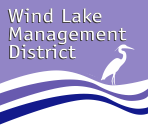Wind Lake Management District Projects
A sampling of the rehabilitation projects undertaken on Wind Lake to date includes: development of a lake management plan, dredging, water quality monitoring, an alum treatment (nutrient reduction), watershed activities, sensitive land acquisition, shoreline stabilization, local lake ordinance improvements, carp removal activities and aquatic plant control. Read the Aquatic Plant Management Plan. The harvesting and chemical treatment permits are based on this plan.
Harvesting
WLMD contracts for harvesting when weed conditions are severe. Because conditions on Wind Lake fluctuate from year to year, harvesting is not needed every year. Harvesting is used to open navigational access through large milfoil beds in the main lake. View the 2018 – 2022 Harvesting Permit.
The 2019 Annual Meeting directed the board to do the investigation necessary to purchase equipment needed to begin a harvesting program. Mike Bluemel and Bruce Rosenquist had some preliminary information for the meeting to consider, however the property owners want a full proposal to vote on. They will put together details and costs that will need to include equipment, staffing, storage, insurance, maintenance, disposal and off-leading. They will also provide information on the committee meetings and progress so it can be posted on the website. Three property owners also provided their contact information to assist with the investigation.
Chemical Treatment
Each year, the WLMD, under permit from the Wisconsin Department of Natural Resources (WDNR), contracts to have some aquatic plants chemically treated. Treatments focus on invasive species, and plants that impair recreational use. The treatments are planned to reduce the chemicals used while providing the relief that property owners, and lake users need.
All chemical treatments are conducted by companies licensed by the State of Wisconsin and certified in aquatic plant chemical control. Chemical treatments are supervised by WDNR. All affected lakefront landowners are notified of upcoming treatments, and will receive a copy of the permit applications submitted to WDNR. If an area is treated, bright yellow signs are posted every 500 feet of the treated area to inform the public and the property owners. Signs indicate what chemical was applied, when it was applied, and if there are any use restrictions.
The majority of the treatments conducted on Wind Lake are for algae and Eurasian water milfoil. In general, treatments are only conducted within 150 feet of the shoreline of developed properties when a nuisance exists. View the Current Chemical Treatment Permit.
Water Quality Testing
The WLMD contracts the U.S. Geological Survey (USGS) (a division of the U.S. Department of Interior) to collect water quality information on Wind Lake. As of 2016, there is now a 30-year history of information. Water quality information is very important in planning and implementing lake management activities. The data can show whether or not a project has been successful in meeting its goals, or whether a new problem is occurring. It is important to remember that 30 years of data is only a small snapshot in the life of a lake. Trends can be seen only after years of information are available.
Water samples are collected in April, June, July, August, October and February. The data includes: dissolved oxygen, nutrients (phosphorus and nitrogen), pH, conductivity, clarity, suspended solids, temperature, and others. The most recent information is available ???.
The USGS also maintains automatic lake level recorders that are located at the Wind Lake Dam and the Big Muskego Dam. The recorders measure the level of the water in the lakes every 15 minutes, 24 hours a day, 365 days a year. The information is uploaded to the USGS web site for almost instant retrieval.
Canadian Geese Contaminant Study
In many areas in SE Wisconsin, Canada goose populations have expanded so rapidly that they have become a severe nuisance. The non-migratory birds create nuisance conditions in parks and open spaces, and along lake shores. The geese leave behind droppings that create health hazards and water quality impairment.
Control methods include the harvest of urban geese for donation to food and wild game pantries. Wind Lake has participated in a USDA goose removal program to improve conditions and water quality since 2007.
A 2015 report discusses results of Contaminant Testing of tissue from geese that were harvested from urban sites in the region and evaluates the need for any consumption advisories.
